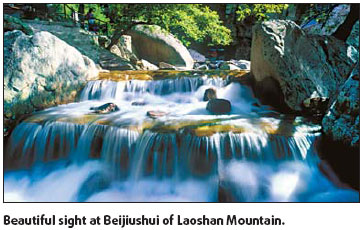Laoshan Mountain a botanist and skipper's delight
Updated: 2007-08-15 07:03

QINGDAO: China boasts the "Five Yue", but none of the country's famous mountains boasts the fresh sea air that makes Laoshan Mountain so special.
Qingdao's famed ancient mountain soars 1,132m above sea level and is one of few peaks skirting China's coastline.
There is a saying that Mount Tai (one of the Five Yue) is magnificent, but a one-day tour of Laoshan Mountain is enough to be convinced it takes the cake.
Bordering on Laoshan Bay in the east and close to the Yellow Sea in the south, sea and mountains link together in a divine coalition of water vapor, shadows, fog and light to make Laoshan Mountain truly mystical.
Adorned by waterfalls among a sea of clouds, green trees and bamboo, Laoshan Mountain boasts unforgettable scenery.
Its expanse is also an ideal place for exploring.
At the foot of the mountain, a rock is inscribed "the first famous maritime mountain", underlining her importance to those she hosts and crews whom draw comfort from her on distant peaks and troughs.
Laoshan is the only coastal mountain that soars more than a kilometer above sea level and the only visible from tens of kilometers to edgy sea captains.
The cool relief of Longtan Waterfall makes you reluctant to leave and is one of the most serene places in China to beat soaring summer temperatures.
The mountain is carpeted in ancient trees such as cypresses of the Han, elms of Tang and gingkoes of the Song dynasties.
Together with cuckoos, larches and more than a thousand varieties of flowers in spring and summer, Laoshan is both mariner and botanist's delight.
Laoshan's most attractive spot is Beijiushui.
Water from Laoshan contains many kinds of minerals.
Each liter is said to invigorate the stomach and the circulation of blood, perhaps the reason for Tsingtao's salubrious taste.
Water from the mountain valleys flows through many bends. Local inhabitants call each of these "waters" and use the number nine, as is customary when Chinese are uncertain of a total, to estimate Laoshan's many bends.
Along the "nine" waters, "Bamboo Shoot Rock", "Camel Rock", "Lion Rock" and other strange rocks tell their own stories.
Every rock boasts a unique shape - some look human, some look animal but all fire the imagination.
On your left, there is a fairy-shaped rock called "Beauty Rock"; on your right a finger-shaped rock called "Fingers Rock".
The 2,100-year-old sprawling Taiqing Palace, is another place to behold.
It was built during the Western Han Dynasty and extended to its current formidable scale during the Song Dynasty.
Made up of more than 140 structures, the palace spans more than 30,000sqm.
It continued to develop to make the mountain a renowned place for Taoists to worship. The main hall in Tanqing Gong is Sanqing Hall whose God is the highest deity of Taoism.
There are more than 100 "fu" letters in different styles on the wall and tourists come to touch them to pray for happiness and good luck.
In front of Sanguan Hall, there are two camellia trees, both about 700 years old.
The famous writer Pu Songling of the Qing Dynasty once visited Laoshan Mountain and created two famous novels, Jade and The Taoist of Laoshan Mountain.
(China Daily 08/15/2007 page24)
|
|
|
||
|
||
|
|
|
|